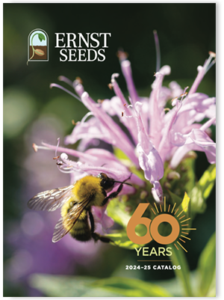Outdoor writer and avid upland game bird hunter Tom Keer discusses the Ernst Seeds story and the finer points of seed selection for habitat development with Randy Ferguson, director of marketing & communications. The article originally appeared in the September/October 2018 issue of Sporting Classics magazine.
Never in a million years did I believe I’d refer to a field as stunningly gorgeous, but this one took the cake. It stretched on nearly forever, with patches of Johnson, wire and switchgrasses interspersed with bicolor lespedeza, pearl millet, both big and little bluestem and a fringe of broomstraw. The land had character, with slight elevations and dips and, in the lower parts, seeps that drained into a series of nearby ponds. Loblolly, longleaf, shortleaf and slash pines added pockets of shade, and big stands of oak formed a perimeter. When I got close to those trees, I smelled charcoal from last spring’s burn.

On a normal day, I’d have already dropped the tailgate and cut loose the dogs, but this field commanded respect. The first time I saw it was nearly two decades ago when it held the final gasp of row crops. The soil was fertile, so the field was covered in soybeans. That year the market price was strong, but throughout its 80-year history, it held cotton, tobacco and even peanuts. As the economy shifted so did use of the land.
When my friend purchased the field 10 years ago, he introduced a new era—a virtual wild sanctuary for all sorts of fish and game. The overhaul expanded the original two or three coveys of quail to nearly 10 times that number. White-tailed deer enjoyed the clover and acorns around the edges while the wild turkeys picked around in the field and woods. In the spring and in the fall, migratory waterfowl over-nighted in the ponds, and schools of bass and bream swam underneath their churning, orange paddles.
My friend accomplished all this with a do-it-yourself approach. His was a little bit of a trial and a lot of error. But it all came about with help that Ernst Conservation Seeds in Meadville, Pennsylvania offers on a regular basis.
Ernst Conservation Seeds, a supplier of native grasses and flowers for commercial and recreational use, is among the oldest such companies in the U.S. It was founded in 1964 when the Beatles occupied the top five most popular music slots, a young actress named Elizabeth Taylor married Richard Burton (for the first time), and Calvin Ernst, a young Penn State intern, sought a solution to a problem.
Major highway projects were underway in his native Keystone State, and steep, roadside slopes needed a green-up combined with soil stabilization. Crown vetch, a legume that grows quickly and establishes deep roots, was favored by the Department of Transportation, so Ernst got to work. When he found a suitable five-acre patch on his family’s farm, he convinced his father Ted to set aside the piece for his crown vetch experiment. He was successful, so a year later, Ernst took another risk and expanded his planting to 200 acres.
A decade or two passed, and as the highways were completed, Ernst was faced with a dilemma: what next? Ernst decided to diversify into other plants for sale and to pioneer a business model that creates beautiful, ecologically healthy environments. In the 1970s and 1980s, the need for Pennsylvania coal dwindled and strip mine reclamation was in full swing. Ernst saw the new opportunity and again rose to the challenge. After careful study, he developed a product line that would grow and shape his company for the next five decades: native grasses and forbs (flowering plants). Native grasses provide an aesthetic far more attractive to view than an abandoned strip mine, but they also create a healthy environment for wildlife. After careful study and thorough testing, Ernst arrived at local grass native to the area. Deer tongue, his first exploration into a native seed crop, was the solution to the problem. While it sounds like a favorite meal of whitetails, deer tongue is preferred by wild turkeys. Go figure.
The majority of Ernst Conservation Seeds’ business focuses on making properties look gorgeous while also having a positive effect on wildlife habitat.
Randy Ferguson, director of Marketing and Communications, says the company’s sales and support teams are devoted to helping commercial and recreational farmers figure out their next steps.
“I’m a big and small game hunter,” he notes. “In fact, over 75 percent of our employees are hunters. The odds are excellent that customers are speaking with someone who has direct experience with grasses, forbs and wild game.
“When making recommendations, we review soil test results to determine soil type, pH, moisture content and nutrient levels. Then, we can look at plot prints or images that detail the property. Water sources, elevation changes and sun/shade variables along with targeted game help us to recommend the correct mixes.
“Most property owners have a clear goal in mind,” says Ferguson. “Some wish to increase an existing quail population while others are more focused on growing whitetail deer herds or turkey flocks.
“Our horticulturists and plant materials specialist travel quite a bit, and they’ll occasionally meet with property owners and managers to review prospective work. They’ll also cover some of the mundane factors to make sure the project is successful. Some of these topics include deciding on fall or spring planting and how the seeds will be sown. Planting methods are key. Small tracts might be hand-sown; dry regions and steep slopes could require hyrdro-seeding, while other terrains are best drill-seeded or mechanically broadcasted. It takes time to create a landscape that is both functional and aesthetically pleasing, with two, three or more growing seasons being required to have a significant impact.”
The company does far more than grow seeds for wholesale and retail sales to farmers, ranchers, commercial and private customers. It’s also committed to education. For more than two decades, the Ernst team has been involved in the Eastern Native Grass Symposium, a program that’s a think tank for native grasses. Presenters are all interested in the research and development of grasslands to benefit grazing and forage, improve soil health, control runoff, improve biodiversity and balance wildlife and pollinator habitat. Seminars are offered by academics and university professors, certified USDA crop advisors, conservation groups and environmental consultants who often focus on creating upland and migratory bird habitat. While the original focus of the symposium was to promote CRP plantings on marginal farmlands, it’s gained momentum and now affects many public and private parcels.
Most recently, landscape architects and designers have become interested in planting sustainable native grasses and forb in meadows and prairies, to the benefit of wild birds and game animals. Small parcels of lands create buffer zones that are now being replanted with native plants to increase not only wildlife numbers, but for selective grazing and controlling surface water runoff. Attendees hear seminars about such topics, with many others focusing on information relevant to plantation owners, small farmers or public land stewards.
There are many ways to incorrectly plant native grasses. Sometimes existing vegetation is not properly eradicated and the remnants overwhelm seedlings. Other times the soil’s pH is out of alignment and must be augmented prior to planting. To create a field full of quail like my friend’s requires time, patience and knowledge. And that’s where the folks at Ernst Conservation Seeds fit in. In many instances they should be on a landowner’s speed dial.


